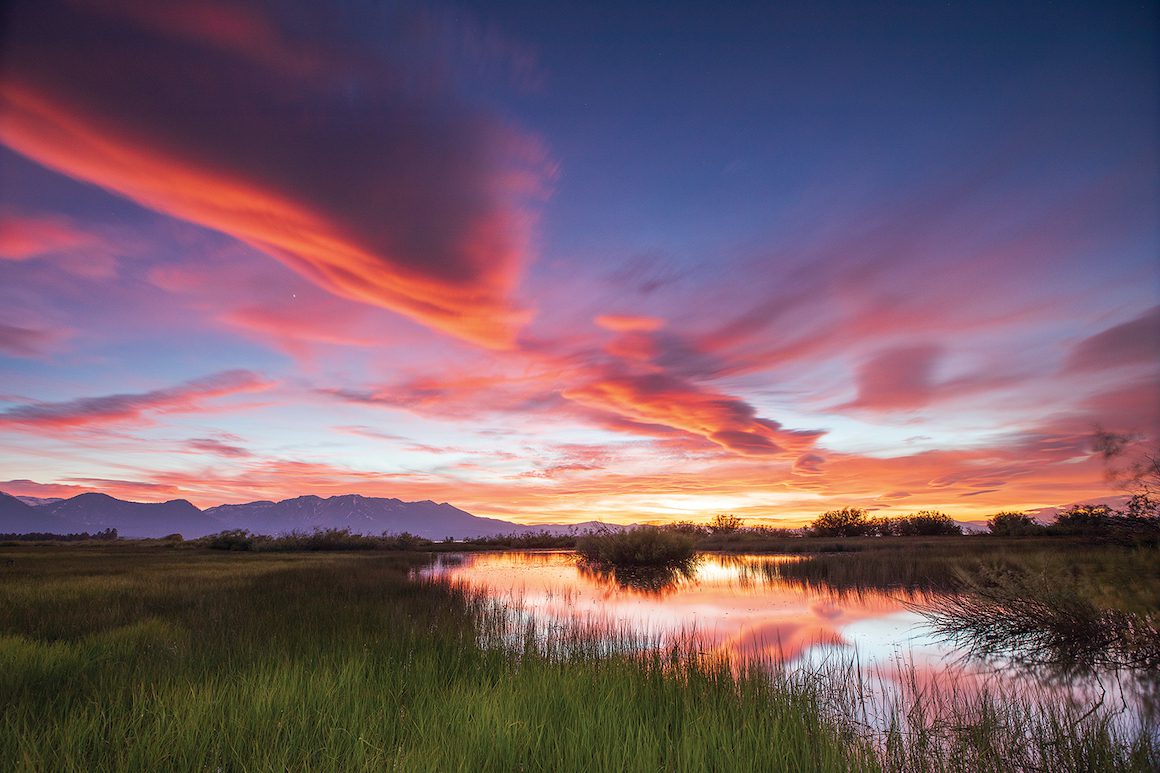
01 Jul Eye to Eye With Heather Gaburo
A self-taught Tahoe photographer quietly excels at her craft
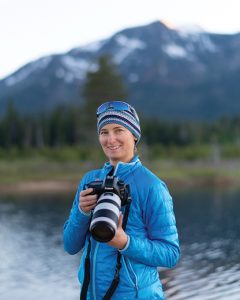
Photographer Heather Gaburo, photo by Brent Coe
If it weren’t for TQ’s Best of Tahoe Photo Contest, we might never have discovered the photographic talents of Heather Gaburo.
And that—aside from the many stunning images we receive—is the beauty of the annual contest.
Gaburo, a busy professional who enjoys photography as a relaxing pastime, isn’t big on self-promotion. But her work speaks for itself. That much was apparent in 2022, when the owner of Prismatic Sky Photography submitted an image of a bald eagle swooping over a wind-chopped surface of Lake Tahoe, its wings splayed against a surreal rainbow backdrop. The photo received first place in the Wildlife category, which is no easy feat in a competitive field full of beloved Tahoe bears.
We’ve kept an eye on Gaburo’s work ever since—and even caught up with her recently for a Q&A so we could learn and see more.
Where were you born and raised, and what sort of things were you into as a kid?
I grew up on the East Coast and was lucky to spend a lot of time outside with friends, exploring the woods, building forts, playing games in the street and going to the beach. I also enjoyed reading, which instilled a desire in me to travel.
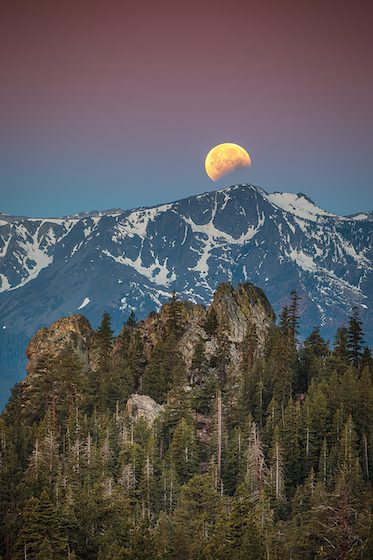
A partially eclipsed full moon sets over Mount Tallac and Castle Rock
How and when did you get into photography?
As a kid, I enjoyed taking photographs with my 35mm film camera, but didn’t focus much on technique. During field trips, I often documented the people and the places we went. Looking back on those early photos, I can see progression from snapshots to more artistic photos. I developed a serious interest in photography during college, as I started to travel more.
What was your first camera?
My first camera was a very basic film point-and-shoot, but I honestly can’t remember what it was. I consider my first real camera to be the Kodak Z730—an inexpensive, compact digital camera with manual functionality so I could learn technique. That camera allowed me to experiment with settings and develop artistic compositions.
Where did you go to college and what did you study?
I studied chemistry as an undergraduate at the College of William & Mary in Virginia and received my graduate degree in pathology at Quinnipiac University in Connecticut.
Your website mentions that you are a teacher and healthcare professional. Can you describe your profession?
I went to graduate school to become a pathologists’ assistant (PathA), a physician extender similar to a physician assistant but specializing only in pathology. PathAs work closely with licensed pathologists, preparing and examining tissue samples removed during surgery, so the pathologist can make the diagnosis for the patient. It’s a rewarding and stressful career with many time-sensitive tasks. Photography has been one of my creative outlets for stress management, along with yoga.
How did you become adept at photography (school, self-taught, a mentor, etc.)?
Most of my education is “self-taught,” though I am constantly learning from others. I’ve learned a lot from experts by reading articles, listening to podcasts, attending workshops and seminars, and talking to other photographers. I didn’t take photography classes in high school or college, but I did take a biomedical photography class in graduate school.
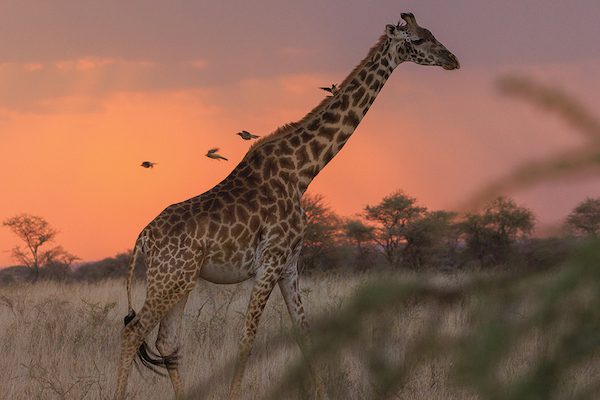
A Masai giraffe wanders the Serengeti at sunset as hitchhiking oxpeckers take flight
How do you manage to balance your time between photography and your profession?
I do my best to make the most of the time I’m not working. I prefer outdoor photography, and luckily the best light of the day—golden hour—is usually before or after working hours. One thing I’m constantly working on is accepting the moments I am unable to be out there.
When did you move to Tahoe and why?
This is my fifth year living in Tahoe. I ended up here through a bit of luck and a lot of love. Fifteen years ago, I moved to Southern California ready for a break from East Coast winters and fell in love with the diverse landscapes and light of the West Coast.
While living in San Diego, I felt drawn to the Sierra Nevada, though I couldn’t explore them as often as I desired. My partner grew up visiting Tahoe with his family every winter and always dreamed of living in a mountain town. In 2019, he found a job with a local agency, and I was fortunate to join him in fulfilling his dream a year later.
What’s kept you here?
We’re surrounded by beautiful vistas, abundant wildlife and endless outdoor opportunities. What’s not to like (other than housing prices)? I might have moved to California feeling tired of winter, but after living in Tahoe, I’ve come to love it—the mountains provide a different kind of winter. Dare I say I didn’t even mind all the snow-clearing during our record winter of 2022-23. I’ve even noticed a decreased desire to travel too far from this place, because every month has a unique opportunity for photography. I feel incredibly lucky to live here.
What sort of photography do you pursue when home in the Tahoe Basin?
I’m a nature photographer, typically focusing on landscape and wildlife. The name Prismatic Sky Photography comes from my love of those brilliant sunsets that encompass the entire sky and the crepuscular rays that radiate from the horizon.
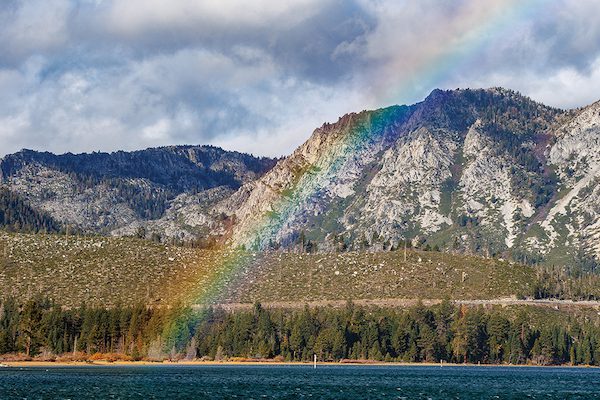
A rainbow over Emerald Point on Tahoe’s South Shore
I love the challenge of capturing a photo that conveys the joy of that moment: experiencing a sunrise or sunset with the sound of waves lapping gently at the empty shoreline, observing freshly fallen snow after a storm, encountering a group of coyotes in the meadow or catching the light shining through the trees to create a brilliant display of color. When photographing landscapes and nature, I aim to capture fleeting moments of natural beauty, preserving unique perspectives and lighting in my photos. I enjoy playing with perspective in my moon photos and hope to inspire people to see the world in a different way.
This year, I’ve been focused on bird photography, as I’m participating in the Tahoe Big Year hosted by the Tahoe Institute for Natural Science (TINS). In addition to broadening my bird portfolio, I’ve met a lot of fantastic people, witnessed some neat bird behavior and continue to improve my ability to recognize birds by sound. The collective group has already seen 200 species since January 1!
Your website also mentions your world travels. Are there any places you’ve enjoyed photographing in particular?
Speaking of perspectives, a 2010 trip to Paris comes to mind because I had a goal of getting a unique photo of the moon with the Eiffel Tower. This was before the photo planning apps existed, though moon azimuth data was publicly available. I scouted locations across Paris using the data and Google Earth, and developed a plan for each night I was in the city. As the moon started to rise next to the tower, I was ecstatic—they lined up even better than I had expected. It’s one of my favorite photographs. I also enjoyed photographing the mountains and glaciers of Switzerland, as well as viewing older photographs of the areas that show the dramatic changes over time.
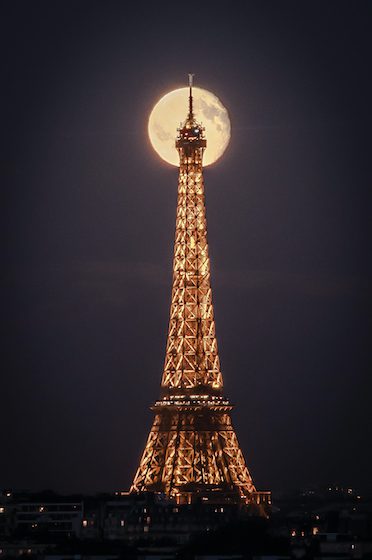
A full moon rises behind the Eiffel Tower in Paris in September 2010
What is your current camera/lens setup?
Despite my first dSLR being a Nikon, I’m now a Canon shooter and recently dipped my toes into the mirrorless world with the R7. Paired with my favorite lens, a 100-400mm telephoto, and the occasional teleconverter, the crop sensor provides impressive reach for wildlife photos. I still have my full-frame dSLR and will pair it with a wide-angle lens for those brilliant sunsets that light up the entire sky.
What do your private group lessons entail?
Group lessons are fully customizable based on the desires of the participants and last for two hours. Topics include compositions, getting to know your camera, exploring different exposure modes, telling a story and a focus on wildlife. They can even be tailored to be a photo tour of photographic locations.
What sort of sporting events do you enjoy photographing and why?
Before living in Tahoe, I photographed swing dance events in the San Diego area. My favorite thing about photographing people is capturing moments of pure joy!
Can you explain your philosophy in regards to your photography?
My photography philosophy is centered on respect for the natural world, ethical practices and a commitment to conservation. I believe that as photographers, it’s important to be advocates for wildlife, balancing the desire to capture unique photos with respecting the boundaries and natural behaviors of the animals we photograph.
We must be mindful of the consequences our actions have on their health and habitat. No matter the distance, once animals notice our presence, we have impacted their trajectory. Sometimes, unphased, they stay; other times they move away from us. By understanding animal behavior, we know when to end or modify an interaction. Advances in camera technology enable cropping as a tool to produce high-quality photos while maintaining appropriate distances. I believe patience and respect are essential and create space for authentic and responsible captures.
I also believe we are stewards of the land and strive to capture the world as it is, preserving its authenticity and beauty without causing harm or disruption. My goal is to capture images of natural beauty as close to perfect in camera as I can. Sometimes this requires the use of polarizers or neutral density filters. I try to keep post-processing to what would be allowed in a wildlife photography contest—basic developing (adjusting exposure, contrast, highlights, shadows in the photo to make it look realistic), white balance adjustments, cropping and sharpening.
Innovation in software and technology have revolutionized the digital art and photography landscape with the ability to create sophisticated composites, sky replacements and generative AI images. With these powerful tools comes a responsibility for transparency to maintain trust and integrity, set realistic expectations for audiences, and foster appreciation for artists and their creative processes.
Are there any specific photographers out there who inspire you?
I’m inspired by the work of Paul Nicklen, Cristina Mittermeier and the late Galen Rowell. They have made significant contributions to the fields of conservation and nature photography, telling impactful stories with their photos to raise awareness and inspire change. As I spend more time in the field, I feel more connected to Rowell’s approach of being engaged with the natural environment to capture its true essence. Whether I’m backpacking, day hiking or trail running, I always carry a camera.
What advice would you give an aspiring photographer in the Tahoe Basin?
Research the local wildlife and their behaviors. Familiarize yourself with the local lands, land managers, and land rules and hours. Get out and explore at different times of the day. Take lots of scouting photos and be open to experimenting!
What are your future goals with your photography?
Some of my goals include finding new perspectives in familiar places and with familiar subjects, and enhancing my ability to tell stories, raise awareness and promote conservation through my photography. I’m also catching up on my photo editing, sorting through countless images from recent wildlife encounters and trips that I’m excited to share. In addition to editing, I’m making it a priority to make regular updates on my website and social accounts.
Find more of Gaburo’s work at prismaticsky.com.
Since Heather Gaburo first participated in the Best of Tahoe Photo Contest, TQ editor Sylas Wright looks forward to seeing what she submits, particularly in the Wildlife and Landscape categories. This year was a porcupine, which placed second, and the rainbow over Emerald Point that appears with this Q&A.




No Comments